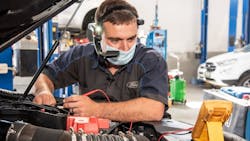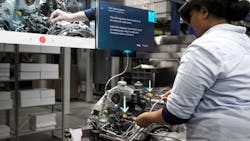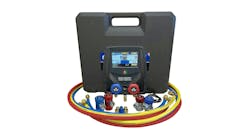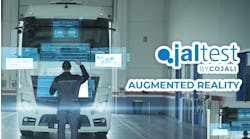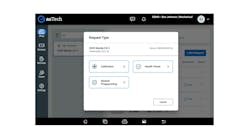Augmented reality enhances the user’s environment by overlaying digital information on what a camera sees. It gained popularity via video games such as Pokémon Go, where players could capture digital Pikachus in the park. But there’s more to AR than fun and games, with the technology being used across several industries to provide more context to jobsites, from hospitals to factories and even vehicle repair shops.
And there’s more than one way to augment the job. Peterbilt technicians use the traditional mode of AR, using tablets enabled with ARTech software to determine how wires run through a truck, giving them artificial X-ray vision.
“The idea has always been around trying to help service technicians locate harnesses without having to read a book describing where it is,” explained David Yin, ARTech product manager at Peterbilt. “Instead, [AR is] showing them where it is. And now we have the technology and the hardware to be able to give it to them on an iPad.”
Assisted Reality, meanwhile, is a simpler form that requires a wearable computer headset, such as RealWear’s Navigator 500. The user sees the world as normal, but can access information to aid their work through a small monocular display. According to RealWear, this design choice was inspired by Star Wars bounty hunter Boba Fett’s rangefinder. The ruggedized wearable can be operated completely handsfree by voice commands. A technician can pull up work instructions or make a call to remote expert, who can see what they see through a camera, to talk them through a process, using virtual communication software such as Microsoft Teams, Zoom, or TeamViewer.
The Microsoft HoloLens 2 represents the most immersive form: mixed reality. This wearable headset can place 3D images (holograms) within a user’s full field of view. Simple hand gestures such as tapping or pinching motions operate the digital interface.
Through various software applications, these high-tech tools aid in enhancing productivity, while decreasing the likelihood for mistakes. During the pandemic, when safe distancing was the “new normal,” Daimler Truck North America used the HoloLens 2, paired with Dynamics 365 Remote Assist and Teams, to connect service technicians with DTNA’s experts.
“This is one of the many solutions we are exploring to address the growing concerns of technician training and availability, with the added benefit of allowing for better social distancing,” said Stefan Kürschner, SVP of Aftermarket at DTNA when the technology was being piloted in 2021. “The HoloLens technology could be a game-changer for driving 24-hour or less repair turnaround, reducing the training time for technicians, as well as time spent in the service bay focused on vehicle repair and throughput.”
Read more: Hands-on maintenance gets assist from hands-free wearable computer
The remote expert aspect is key to improving uptime.
“From the moment the technician puts their headset on, at a minimum, they have a call center on the other line guiding their repair and leveraging augmented reality to be able to parlay into the discussion service bulletins, service manuals, anything necessary for that particular issue that they’re facing, and fault codes that they see that they want to show the technician documentation of on the fly,” explained Daoud Chaaya, director of field service, DTNA to Fleet Maintenance in 2021. “This also allows for subject matter experts to be a part of that call. If we’re talking about an HVAC issue, and I want to rope in my HVAC engineer, they can also be virtually part of that call – this way, you get to bring in expertise, as needed, into a particular repair.”
Training also greatly benefits from all forms of AR. With RealWear’s device, a technician can simply say “Record” while completing a preventive maintenance task and the shop now has a quick training video saved to the cloud.
With Design Interactive’s XRMentor software running on a HoloLens 2, trainers can livestream first-person lessons full of virtual elements like diagrams to several other technicians who can see on a smart device or laptop. As the HoloLens 2 costs $3,500, this is more economical than providing each employee with one.

